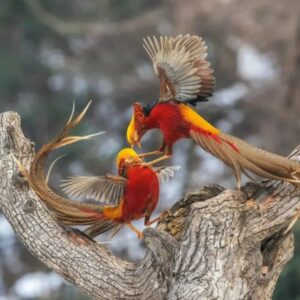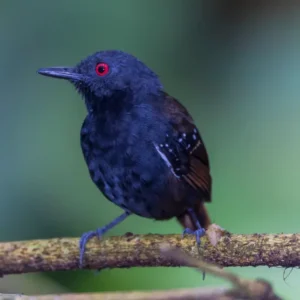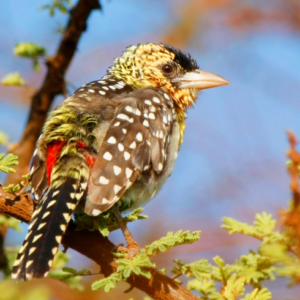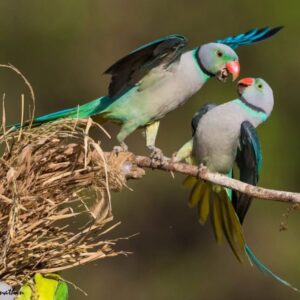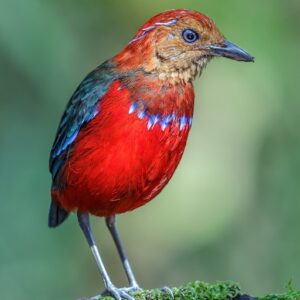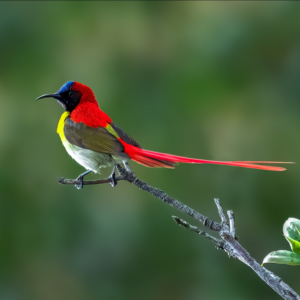
The hyacinth macaw is an unmistakable bird, thanks to its enormous size and bright coloration. It is about 100 cm (39 in) long from the tip of its tail to the top of its head, making it longer than any other species of parrot. Its wingspan is approximately 1.2 m (4 ft). Adult hyacinth macaws weigh about 1.2 to 1.7 kg (2.6 to 3.7 lb).
The plumage of these macaws is predominantly cobalt blue, with bright yellow eye rings around the eyes. Their beaks are two-tone, gray and black, which are exceptionally strong and powerful. The bare skin of the face around the eyes and beak is a wrinkled black color. His toes are grayish with black nails.
Juvenile hyacinth macaws have darker plumage than adults, appearing grayish with less vivid blue and yellow colors. Their irises are brown instead of yellow. As they mature over 3 or 4 years, their plumage gradually takes on the brighter colors of adults.
The hyacinth macaw inhabits lowland tropical forests, palm swamps, and savanna forests. Its range extends across much of central and eastern South America, mainly in Brazil but also in eastern Bolivia and Paraguay.
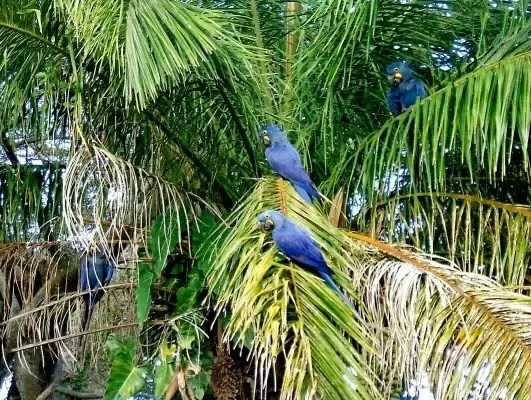
Within their natural habitat, hyacinth macaws prefer palm swamps and tropical forests with an abundance of palm trees. Two species of palm trees in particular are extremely important to their survival:
- Acrocomia aculeata: The Acuri palm provides nesting sites for Hyacinth Macaws, as they nest in natural holes in these trees. Macaws also eat the fruits of this palm.
- Attalea phalerata: The Bocaiuva palm is another key food source, as hyacinth macaws feed on the nuts of this palm. These palm trees form a fundamental part of the hyacinth macaw’s ecosystem, providing them with food and nesting resources. In return, macaws play an important role as seed dispersers of these palm species.
Along rivers, hyacinth macaws nest in manduvi trees (Sterculia apetala) when available. They prefer to use older trees with existing nests.
In general, the population density of the hyacinth macaw is low even in optimal habitat. Each breeding pair needs access to a large amount of nuts and palm fruits within their large territory. Therefore, mature, undisturbed palm swamps with abundant food resources are an essential requirement to sustain wild populations of this magnificent bird.
- Brazil nuts – one of the mainstays of the hyacinth macaw’s diet in the wild. These large nuts are high in fat and protein. Macaws’ strong beaks allow them to easily open the hard shells.
- Palm nuts: The nuts of the Acrocomia aculeata (Acuri) and Attalea phalerata (Bocaiuva) palms are another vitally important food source. These nuts also have very hard shells that the macaws’ powerful beaks can withstand.
- Fruits: Palm fruits are frequently consumed, especially the fruits of Acrocomia aculeata. Other fruits that the hyacinth macaw eats include pineapple, melons, and native berries.
- Seeds: Hyacinthine macaws supplement their main diet of nuts and fruits with various seeds. They are often obtained from seed pods or even collected from the forest floor.
- Corn: When available, corn provides an abundant food source that is easily found in the soil. Hyacinth macaws have adapted to take advantage of corn crops at the edges of the forest.
- Coconuts: Coconuts are prized for their fat and protein content. Hyacinth macaws have specialized beaks capable of breaking through the hard shell to access the interior.
- The hyacinth macaw has a varied omnivorous diet, but palm nuts probably provide most of the calories and nutrients needed to sustain these large, active birds. Their powerful beaks allow them to access well-protected food that other animals cannot.
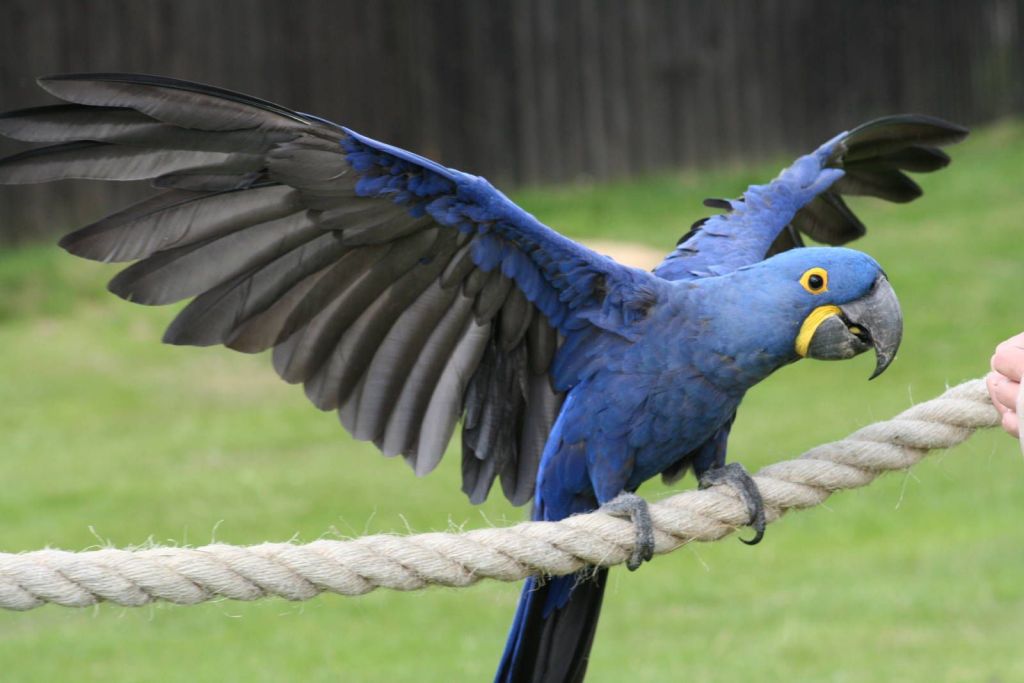
Hyacinth macaws are very social birds that fly in pairs or flocks. Their loud laughter and squeals can be deafening in communal resting places. These vocal macaws use their calls to communicate with flock members and attract mates.
Hyacinth macaws mate for life. Their courtship display consists of ritually grooming each other, mirroring each other’s movements, and feeding each other. Once paired, hyacinth macaws remain monogamous for life.
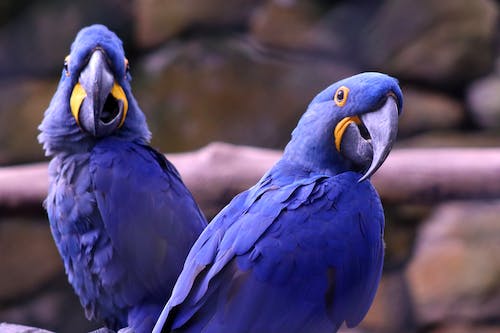
The breeding season for hyacinth macaws varies depending on geographic location. In the Pantanal reproduction occurs from July to December. In Bolivia and Paraguay, reproduction occurs earlier, from April to June. The female typically lays 2 to 3 eggs in a nesting cavity and incubates them for about 28 days. The chicks leave the nest at around 110 days of age.
IUCN Red List Status: Vulnerable Population – The total population is estimated to be between 3,500 and 5,000 mature individuals based on data from the cage bird trade and field studies. Population trend: declining. The hyacinth macaw population has suffered a rapid decline of 50-80% in the last 60 years. Primary Threats: Habitat loss due to deforestation: Logging, fires, conversion to agriculture and ranching have destroyed much of the macaw’s native habitat. Palm swamps are especially at risk. Illegal pet trade: Poaching of wild chicks and adults for the caged bird trade has severely affected wild populations. Hunting: Some hunting is practiced in local communities for food and feathers. Competition for nesting sites: Competition with Africanized bees and other birds for nest cavities can limit reproduction. Protected Areas: Hyacinth macaws are found in some protected areas in Brazil, Bolivia and Paraguay. Major reserves include the Araras Ecological Station and the Taim Ecological Station in Brazil. Conservation actions: Protected areas, nest box programs, ecotourism projects, trade restrictions, and educational programs to discourage poaching. Captive breeding initiatives can help meet demand from the pet trade.
The precarious state of the hyacinth macaw underlines the need for greater protected habitat and anti-poaching measures to prevent this species from approaching extinction.
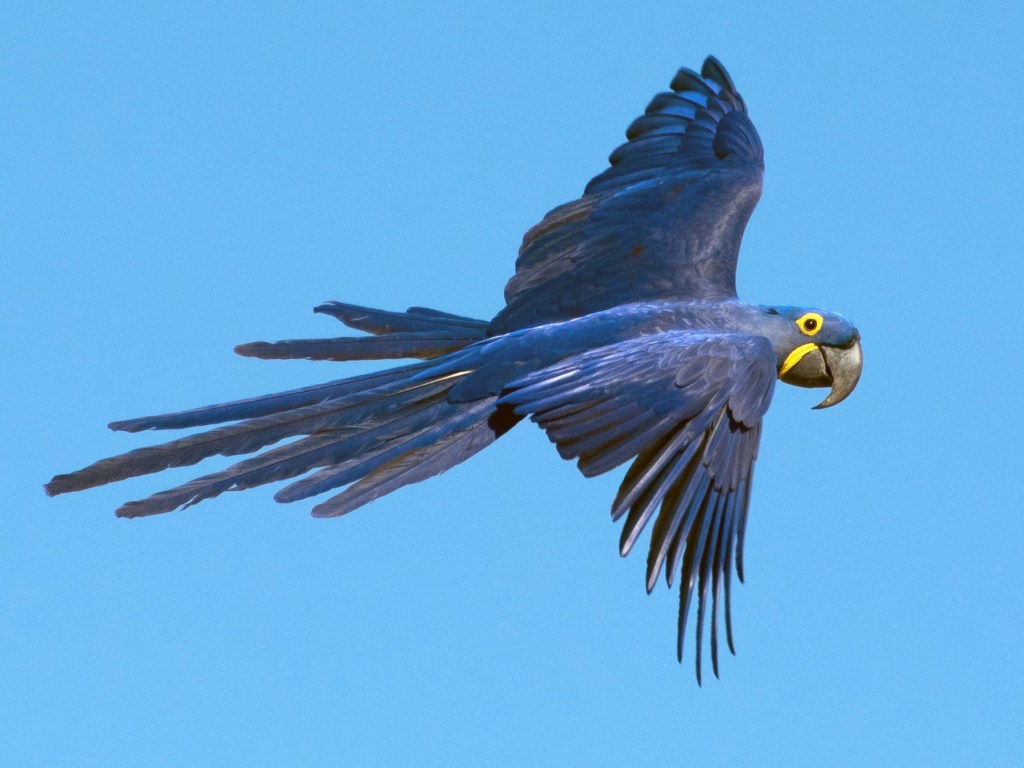
- Size: 100cm long; 1.2-1.7kg weight
- Plumage: Vibrant cobalt blue with bright yellow eye rings.
- Beak: Large, curved gray/black beak. Powerful bite force.
- Habitat: Lowland rainforests, palm swamps and savannahs.
- Diet: Nuts, seeds, fruits. Prefers palm nuts.
- Behavior: Social, monogamous pairs, loud vocalizations.
- Status: Vulnerable, between 3,500 and 5,000 individuals remain.
- Threats: Habitat loss, illegal pet trade.
The hyacinth macaw is one of the most iconic parrots in the world. From the striking, deep blue of its feathers to its incredible size, this macaw has captivated people for centuries. Although they face serious threats in the wild, conservation efforts focused on habitat protection and anti-poaching can help ensure the survival of these majestic birds into the future.
The Hyacinth Macaw is a South American national treasure that deserves full protection to fly freely in its natural range. With dedicated conservation actions, future generations will be able to continue marveling at the Hyacinth Macaw soaring through the skies of the Amazon.
